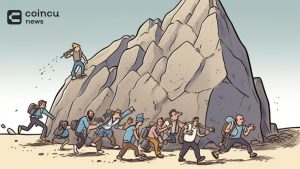Collaborative artists are an undeniable cornerstone of modern popular culture. Ultimately, it is the amalgamation of creative minds captured in a single work of art that inspires audiences, critics and the creative community.
Take “The Marilyn Diptych” by American pop art pioneer Andy Warhol. Iconic artwork based on a public photo of Marilyn Monroe in the 1953 horror film Noir Niagara. Regardless of the actress’ undeniable appeal, the picture itself was low profile until Warhol made it, making it one of the most admired masterpieces of the 20th century. But is that possible? Doesn’t painting benefit from painting? After all, it’s her photo – not Andy’s. While this is a closed case, there are millions of similar cases. And a new generation of unusable tokens (NFTs) could be exactly the solution artists have been hoping for.
Related: Bull or bear market, creators are diving headlong into crypto
Enter NFT. a
The immutable sign turns the art world upside down by providing illustrators, musicians, fashion designers (and virtually anyone) a safe way to distribute original works while maintaining copyright and reproduction rights. At the same time, collectors receive blockchain-protected ownership of these pieces. What if collectors want to use the collected works as a basis for composing their artwork? Upgrade them, you could say. Can the NFT guarantee legal participation in art?
Upgrades can take any form. For example, a brave collector could draw a red line on Beeple’s $ 69 million NFT, or take Hokusai’s recently digitized “The Great Wave” and add a surfboard. But exciting as it is, there are legal issues to deal with, so the risk may be worth mentioning. With the updatable features of NFT, everything can be done in a unified framework. Artists can post multiple copies of their NFT so only a few are updateable.

Several blockchain players in the NFT space are trying to work in this direction. Wakatta, for example, markets itself as “a blockchain that meets the needs of the entertainment industry”. To achieve this ambitious goal, it has developed a number of new types of NFTs – upgradeable, time-limited, and text-based. From a technological point of view, this network will be developed on substrates, the same technological framework used by Polkadot. Alex Blagirev, Wakatta Project Leader, said, “Digital technology is making it easier for everyone to be a creator. The creative industries are a reality, especially in the entertainment industry, and we need solutions that adapt and improve them. ”He added:
“Immutable tokens and artists are a heavenly combination because of the infinite possibilities they create.”
The same idea could work for other industries: startup ether tokens help create custom NFTs and generate dynamic tokens that trigger discounts, grant access, unlock functions, connect to physical elements, manage, update and change based trigger on real events. They teamed up with basketball player LaMelo Ball to develop a dynamic NFT for him.
A good example of the game industry is Phantasma – a blockchain focused on game applications – which also introduces a similar NFT function for game developers to control when games are available.
Related: Tokens are not corrosive from a legal point of view
NFTs and the music industry
Last year, musicians joined the band NFT as well, with artists like Eminem, Steve Aoki and Grimes selling a total of $ 10 million in NFT copies of their songs. The latter sold a one-of-a-kind video clip entitled “Death of the Ancients” for a whopping $ 389,000.
The music industry is facing increasing pressure from artists around the world to speak out against unfair compensation from streaming players like Spotify and Apple Music. In April, superstars Paul McCartney, Kate Bush and Noel Gallagher filed a joint letter to UK Prime Minister Boris Johnson urging a discussion on online revenue reform. As the complaints pile up, non-erasable tokens are quickly becoming a suitable alternative for artists to distribute exclusive content directly to their fans without intermediaries. Additionally, updatable NFT artists can also easily remix, bypassing the complicated and expensive legal processes often associated with collaborations.
Related: NFTs are a game changer for independent artists and musicians
Temporary NFTs can also be particularly useful in this industry. In a virtual setup, tickets for a concert or music festival can be converted into an NFT, e.g. B. to grant access to certain time windows. As with any other smart contract, companies or artists can configure them for reuse or rate their usage at their own discretion. And after expiration, the tokens can still hold some value and be valued as collectibles and legally re-marketed as memorabilia.

Related: Play and earn is the secret to mainstream adoption of NFT games
Nobody can say exactly what the future will look like. But one thing is certain: NFTs are much more than JPGs with cat motifs. Their use cases are rapidly expanding to new domains, reaching areas previously unexplored by blockchain technology, such as artist collaboration, music licensing, and even events.
\
Alexandra Luzan is a doctorate. Students study the connection between new technology and art at Ca ‘Foscari University in Venice. Alexandra has been hosting technology conferences and other events in Europe dedicated to blockchain technology and artificial intelligence for about a decade. She is also interested in the relationship between blockchain technology and art.
Follow the Youtube Channel | Subscribe to telegram channel | Follow the Facebook page












